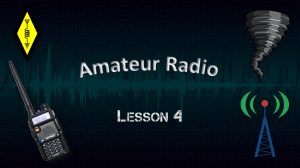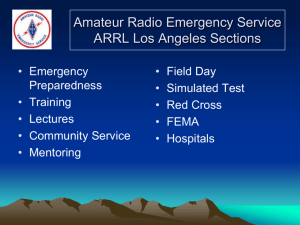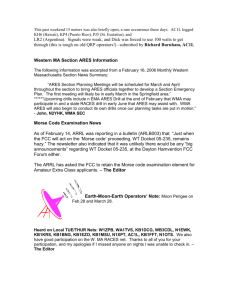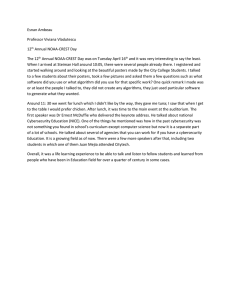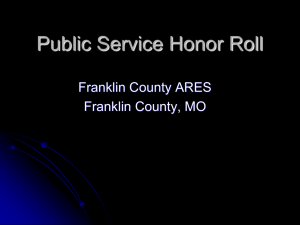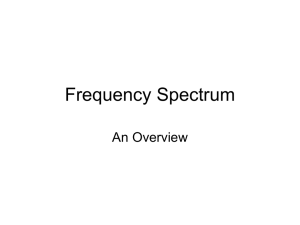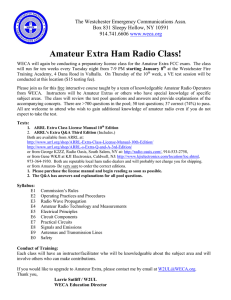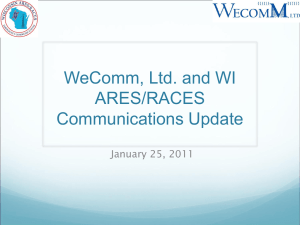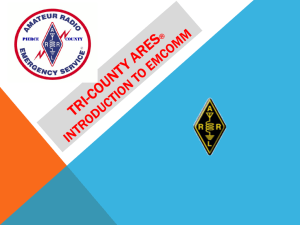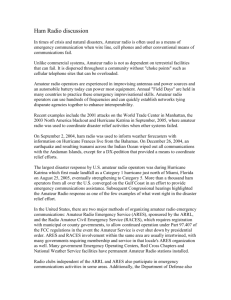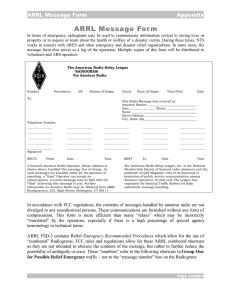Session 1
advertisement
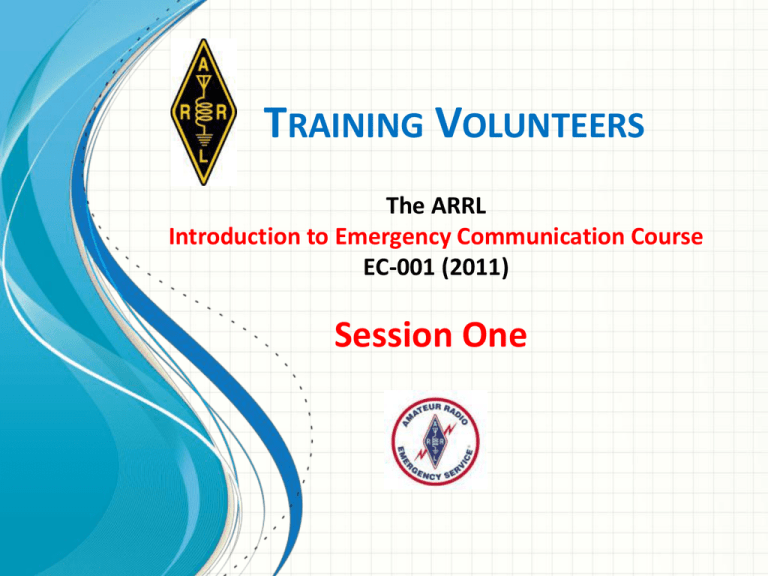
TRAINING VOLUNTEERS The ARRL Introduction to Emergency Communication Course EC-001 (2011) Session One Introduction to Emergency Communication Course Developed for ARRL STX By Lloyd Jeffries, K1LGJ Credits for some original work included in these slides goes to: I thank the American Radio Relay League (ARRL) for permission to use copyrighted EC001 course material that is included in this classroom presentation material. Original slides used and modified for this presentation were developed by Brian Daly, WB7OML, EC - King County (WA) District M Western Washington Medical Services Team and leadership team of the Seattle ACS. Supplemental material has been obtained through various sources including FEMA, Citizen Corps website (CERT) , Washington State ARES/RACES, King County ARES/RACES, South Texas ARES, Williamson County, TX ARES/RACES and others too numerous to mention. Permission is granted to any amateur radio team to use provided credit is given to the developers. Course Requirements • Completed two DHS/FEMA Courses • IS-100.b Introduction to ICS • IS-700 National Incident Management System Http://training.fema.gov/IS/NIMS.asp • Must be complete before taking the final exam! Recommended • IS-250 Emergency Support Function • IS-288 Role of Volunteer Agencies Note: An Amateur Radio License is not required Introductions & Expectations • Who am I? • Your Name, Callsign and Expectations • My Expectations Objectives • The main goal of these sessions: To establish a baseline level of knowledge and skill in Amateur Radio Emergency Communication for anyone wishing to assist their local emergency communications organizations Overview • We are here to improve professionalism and effectiveness of our public service efforts • Learn new skills, new ways of thinking about existing skills • Share stories of how this applies to our local teams Classroom Logistics • • • • • Environment Very Informal Open Discussions (time permitting) Review answers to Lesson Questions Prepare for the final exam Course Flow Six Sections with 29 Topics 1. 2. 3. 4. 5. 6. The Framework: How You Fit in The Networks for Messages Message Handling What Happens When Called Considerations Alternatives and Opportunities Final Exam - 35 Questions - score 80% or better - $15.00 Fee Course Flow (cont.) Six 3-hour Sessions Session 1 – Topics 1, 2, 3, 4, 5a, 5b Session 2 – Topics 6, 7a, 7b, 7c, 7d, 8, 9, 10 Session 3 – Topics 11, 12, 13, 14, 15 Session 4 – Topics 16, 17, 18, 19, 20 Session 5 – Topics 21, 22, 23, 24, 25, 26, 27 Session 6 – Topics 28, 29, Summary, Final Exam Topic 1: Introduction to Emergency Communication What is a Communication Emergency? • A Communication Emergency exists when: – A critical communication failure puts the public at risk What are some potential causes of a “Communications Emergency” locally? Exercise • Rank in order the following disaster risks for local Texas Counties in your area from highest risk to lowest risk • • • • • • • • • • • • Windstorms Air Crashes Landslides Terrorism Hazmat Incidents Volcanic Eruptions Earthquake Tornadoes Snowstorm Civil Disorders Floods Droughts/Water Shortages What Makes a Good Emcomm Volunteer? • Common Attributes: – Desire to help others without personal gain of any kind – Ability to work as a member of a team Where Do You Fit In? • Amateurs bring: – Equipment – Skills – Frequencies – Can create expedient emergency communications networks under poor conditions However…. Where Do You Fit In? • Radios, Frequencies and Basic Radio Skills are not enough! • Without specific emergency communication skills, you can easily become part of the problem • Technical and Operating Skills are critical… – But so is your ability to function as a team player within your organization as well as the organization you are serving What You Are Not! • There are limits of responsibility as an emergency communicator • Specifically: – You are not a first responder – You have no authority – You can & should make decisions affecting your and your family’s health & safety What You Are Not! • You cannot “do it all” – If the served agency runs short of specialized help, it is not your job to fill it • especially if you are not trained for the job! – But you can fill in an urgent need or perform jobs where communication is an integral part, if you are qualified • You are not in charge! Leave your ego at the door! Day-to-Day vs. Emergency Communications “Day-to Day” Amateur Radio – – – – No pressure to get a message through Do things at your leisure No one’s life depends on it Public Service Events • Scheduled and Planned – Even SETs are mostly relaxed and scripted Day-to-Day vs. Emergency Communications “Emergency Communications” Amateur Radio – May involve both Amateurs and non-Amateurs – Happens in real-time • Unplanned, little or no warning • May go on for several days – May have several nets simultaneously • Pass critical messages in a limited timeframe – Portable stations, quickly set up and operational anywhere The Missions • Can vary with specific agency served – American Red Cross • Provide communications needed to maintain shelters and other relief efforts – State/Local Emergency Management • Interagency communications • “eyes and ears” of the emergency managers What are some of the missions you might see? Communicating – Job #1 • Important to remember your job is: – “communicating” • Communicating does not automatically imply amateur radios – Be prepared to use any means required Communicating – Job #1 • Our job – GET THE MESSAGE THROUGH – Don’t think ONLY about how to use the ham radio to send the message --– Just think about the best and fastest way to send it • If the best way is a FAX, cell phone, CB or FRS – use it • If an agency asks you to use their radio system, use it Your Operating Skills are just as important as your Ham Radio Resources Anatomy of a Communications Emergency • Early phase of a disaster – Severe storm “watch” or “warning” period – In many cases, no immediate need for emergency communications • Earthquake may be an exception – Monitor developments and prepare to deploy – Some nets may be activated • Hurricane Watch, Skywarn Anatomy of a Communications Emergency • Once need for more communication resources is identified – Served agency puts out call to volunteers • Emergency Operations Center (EOC) • Field locations • “Rapid Response Team” (RRT) – Minimal, quick response in a very short time – Backed up by a more robust response after 1-2 hours Anatomy of a Communications Emergency • “Resource” and/or “Logistics” nets may be established – Handle incoming emcomm volunteers – Direct resources where needed most – Unassigned volunteers check in and monitor But Once Operations Begin… Anatomy of a Communications Emergency Message Volume Grows Quickly Confusion Batteries Relief Operators Fuel Replacement Operators Radio Failures Food and Water Antenna Failures Sleeping Accommodations Communication Assignments • Staffing a Shelter – Handle calls for information, supplies, personnel • Collecting/Transmitting Damage Reports • “Shadowing” – Communication link for an official • Pass messages outside of the disaster area • Gathering Weather Information • Pass health/welfare inquires • Handle logistical needs for served agency Need for Flexibility • Nets will be set up, re-arranged, and dismantled as needs change – Remain flexible to meet needs of served agency • Over time, communication needs diminish – Nets closed – Operators released Not long after the operation has ended… After-Action Review • Review the effectiveness of response – Within the emergency communications group, and/or with the served agency • Format can be a formal net, email, or face-to-face meeting – Should occur as soon as possible Critiques done properly can greatly improve your organization’s – and your own - effectiveness Summary • Any questions before the quiz? Topic 1 Question 1. When does a communication emergency exist? A. Whenever the public is at risk B. When there is an earthquake in your area and the public is inconvenienced C. When a critical communication system fails and the public is inconvenienced D. When a critical communication system fails and the public is put at risk Topic 1 Question 2. Which of the following is it most important for an emcomm group to do at the end of an emergency communication operation? A. B. C. D. Review the effectiveness of its response Take photos of the activity Call the local newspaper to schedule interviews Review the activities of the first responders Topic 1 Question 3. Which of the following is NOT a responsibility of emergency communicators? A. Making demands on the agency being served B. Having radios, frequencies and basic radio skills C. Being licensed and preauthorized for national and international communication D. Possessing emergency communication skills Topic 1 Question 4. Which of the following describes the function of a Rapid Response Team (RRT)? A. To handle large-scale emergencies over an extended period B. To deploy a quick response in a very short time C. To establish and operate a storm watch prior to any emergency D. To review the effectiveness of an emergency communication group Topic 1 Question 5. In an emergency situation -- when a served agency asks you to forward an urgent message -- which one of the following methods would you NOT employ? A. B. C. D. CB radio Family radio Informal, conversational grapevine The served agency's own radio system ANY QUESTIONS BEFORE STARTING TOPIC 2?
